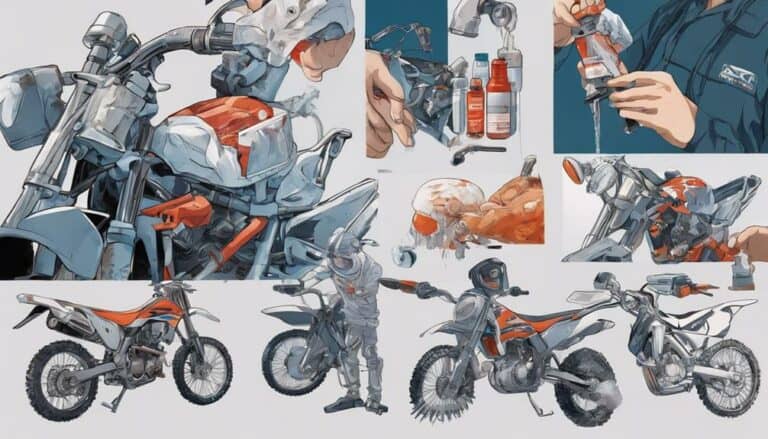You may not know that draining gas from a 2-stroke dirt bike cylinder head is an important maintenance task often overlooked.
But how do you guarantee you're doing it correctly?
The process involves a few key steps to safeguard your engine's health and performance.
Let's uncover the essential techniques to effectively drain the gas and maintain your dirt bike's best condition.
Key Takeaways
- Ensure bike stability and wear protective gear before draining gas from the cylinder head.
- Use proper tools like a syringe and follow safety precautions to extract and dispose of gas.
- Maintain a clean cylinder head by inspecting regularly and cleaning with degreaser.
- Avoid common mistakes like draining gas directly from the cylinder head and seek professional help if needed.
Safety Precautions for Draining Gas
Before draining gas from your 2-stroke dirt bike, it's essential to adhere to specific safety precautions to guarantee a smooth and hazard-free process. Start by making sure your bike is on a stable surface with the fuel petcock turned off to prevent leaks.
Next, wear protective gloves and eyewear to avoid contact with the flammable and harmful gasoline. It's critical to allow the engine to cool down completely before attempting to drain the gas to prevent burns. Additionally, have a suitable container ready to collect the drained gasoline to avoid spills and environmental hazards.
Following manufacturer guidelines and specific bike model instructions is key for safe and effective gas draining procedures. Remember, safety is paramount when dealing with the fuel tank of your dirt bike to prevent accidents and ensure a successful gas drainage process.
Tools Needed for Gas Drainage
To effectively drain gas from the cylinder head of a 2-stroke dirt bike, you'll need a spark plug wrench as one of the essential tools. In addition to the spark plug wrench, here are some other tools you'll need:
- Syringe or Small Tube: Assists in extracting gas from the cylinder head efficiently.
- Clean Container: Use a clean container to collect the drained gas for inspection purposes.
- Well-Ventilated Area: Make sure the area where you're draining the gas is well-ventilated to prevent inhalation of fumes.
- Follow Local Regulations: Properly dispose of the drained gas according to local regulations for hazardous waste.
When removing the carb to access the cylinder head for gas drainage, having these tools ready will make the process smoother and safer. Stay focused on the task at hand and make sure you handle the tools with care to avoid any accidents.
Step-by-Step Guide to Draining Gas
When draining gas from a 2-stroke dirt bike's cylinder head, make sure you have successfully removed the spark plug using the spark plug wrench. Once the spark plug is out, follow these steps to drain the gas:
- Extract Gas: Use a syringe or similar tool to carefully extract the gas from the cylinder head. Be cautious not to spill any gas, especially if the bike has been running lean.
- Stable Surface: Confirm the dirt bike is on a stable surface to prevent tipping or spilling of gas during the drainage process.
- Dispose Properly: Discard of the drained gas in accordance with local regulations to prevent environmental harm.
Tips for Maintaining a Clean Cylinder Head
Clean the cylinder head thoroughly using a lint-free cloth and a degreaser to remove any dirt or residue that may affect engine performance. To maintain a clean cylinder head on your Dirt Bike, follow these tips:
- Regularly inspect the cylinder head for any signs of oil or dirt buildup that could hinder engine function.
- Use compressed air to blow out any debris or particles that may have accumulated in the cooling fins of the cylinder head.
- Check the gasket between the cylinder head and the engine block for any leaks or damage that could lead to loss of compression.
- Make sure to torque the cylinder head bolts to the manufacturer's specifications to prevent any warping or leaks in the head gasket.
Common Mistakes to Avoid
One mistake to avoid when draining gas from a 2-stroke dirt bike is attempting to do so directly from the cylinder head. The gas is typically stored in the fuel tank, so trying to drain it from the cylinder head can lead to confusion and potential damage. It's important to follow the proper technique for draining gas, which involves locating the fuel tank and using the designated drain plug or valve to release the fuel safely.
Another common mistake to avoid is draining gas without the necessary knowledge or guidance. Without understanding the components and procedures involved, you risk causing harm to the engine. Additionally, mixing up the parts of the bike during the draining process can lead to performance issues upon reassembly. Properly identifying and labeling parts as you disassemble them is key to avoiding this error.
Lastly, overlooking other components like the carburetor and fuel lines when draining gas is a mistake that can result in further issues down the line. Make sure that all relevant parts are inspected and maintained during the gas-draining process to prevent complications during future usage.
Conclusion
Now that you have successfully drained the gas out of your 2-stroke dirt bike cylinder head, picture a clean and well-maintained engine ready to hit the trails with top performance.
By following these simple steps and precautions, you can guarantee the longevity of your bike and prevent any costly repairs down the road.
Keep up with regular maintenance and enjoy a smooth ride every time you hop on your dirt bike.

